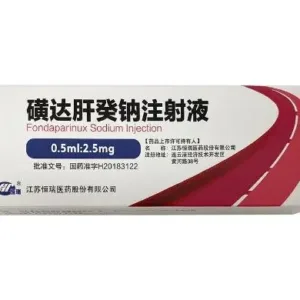Fondaparinux sodium
Function:
Fondaparinux has anti-thrombotic effects and is mainly used in patients with hip fractures, major knee surgery or hip replacement to prevent the occurrence of venous thromboembolic events. For the treatment of patients with unstable angina or non-ST-segment elevation myocardial infarction (UA/NSTEMI) undergoing unindicated emergency (<120 minutes) invasive treatment (PCI). For the treatment of patients with ST-segment elevation myocardial infarction who are treated with thrombolysis or who do not initially receive other forms of reperfusion therapy.
Dosage:
For the prevention of postoperative thromboembolic events in patients undergoing major orthopedic surgery: the recommended dose is 2.5 mg once daily, administered by subcutaneous injection after surgery. The first dose should be given no earlier than 6 hours after surgery and only after hemostasis has been established. Please follow your doctor's advice for details. Treatment should be continued until the risk of venous thromboembolism has decreased, usually until the patient is up and ambulatory, at least 5-9 days after surgery. Experience shows that in patients undergoing surgery for hip fractures, the risk of venous thromboembolism persists beyond 9 days postoperatively. In these patients, fondaparinux prophylaxis should be extended for an additional 24 days. Treatment of patients with unstable angina/non-ST-segment elevation myocardial infarction (UA/NSTEMI): The recommended dose is 2.5 mg once daily by subcutaneous injection. Treatment should be started as soon as possible after diagnosis is made, and treatment should last up to 8 days, or until discharge if less than 8 days have passed. If the patient will undergo percutaneous coronary intervention (PCI), intraoperative unfractionated heparin should be used in accordance with local clinical practice, taking into account the patient's potential bleeding risk and the time since the last dose of fondaparinux. The timing of reintroducing subcutaneous fondaparinux after sheath removal should be determined based on clinical judgment. In the major UA/NSTEMI clinical trials, fondaparinux treatment was restarted no earlier than 2 hours after sheath removal. Treatment of ST-segment elevation myocardial infarction (STEMI): The recommended dose is 2.5 mg once daily. The first dose of fondaparinux should be given intravenously, with subsequent doses given by subcutaneous injection. Treatment should be administered as soon as possible after diagnosis is established, and treatment should last up to 8 days, or until discharge if less than 8 days have passed. If the patient will undergo indirect PCI, intraoperative unfractionated heparin should be used in accordance with local clinical practice, taking into account the patient's potential bleeding risk and the time since the last dose of fondaparinux. The timing of reintroducing subcutaneous fondaparinux after sheath removal should be determined based on clinical judgment. In major STEMI clinical trials, treatment with fondaparinux was restarted no earlier than 3 hours after sheath removal. In patients with ST-segment elevation myocardial infarction or unstable angina/non-ST-segment elevation myocardial infarction, those who will undergo coronary artery bypass grafting (CABG), if possible within 24 hours before surgery Transparinux should not be administered and can be restarted 48 hours after surgery. When subsequent therapy with another anticoagulant is used: If subsequent therapy uses heparin or low molecular weight heparin, the first injection should usually be given one day after the last injection of fondaparinux. If subsequent treatment with a vitamin K antagonist is necessary, treatment with fondaparinux should be continued until the target INR is achieved. Special populations for use to prevent venous thromboembolism after surgery: In patients undergoing major orthopedic surgery, age ≥75 years and/or body weight <50 kg and/or renal impairment (creatinine clearance range 20-50 ml/ min), the time for the first injection of fondaparinux should be strictly adhered to. The first dose of fondaparinux should be administered no earlier than 6 hours after the completion of surgery. Injections should not be administered during this time unless hemostasis has been established. Patients with renal impairment: It should not be used for the prevention of venous thromboembolism in patients with creatinine clearance <20 ml/min. In patients with a creatinine clearance of 20-50 ml/min, the dose should be reduced to 1.5 mg once daily. Patients with mild renal impairment (creatinine clearance >50 ml/min) usually do not require dose reduction. The same medicines produced by different manufacturers may have inconsistent instructions. If you find any inconsistency in the instructions before taking the medicine, please consult your doctor or pharmacist in time.
Drug contraindications:
Disabled if allergic to this product
Related dosage forms:
injection
Share:
Products
Our offers
Health Classification
Let us work together to protect precious health






























